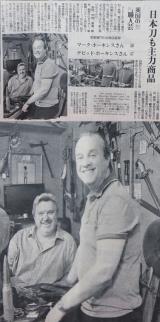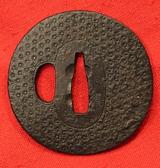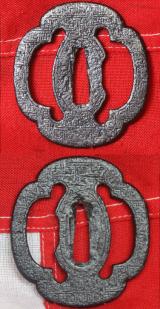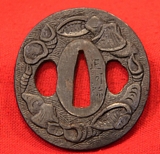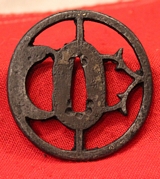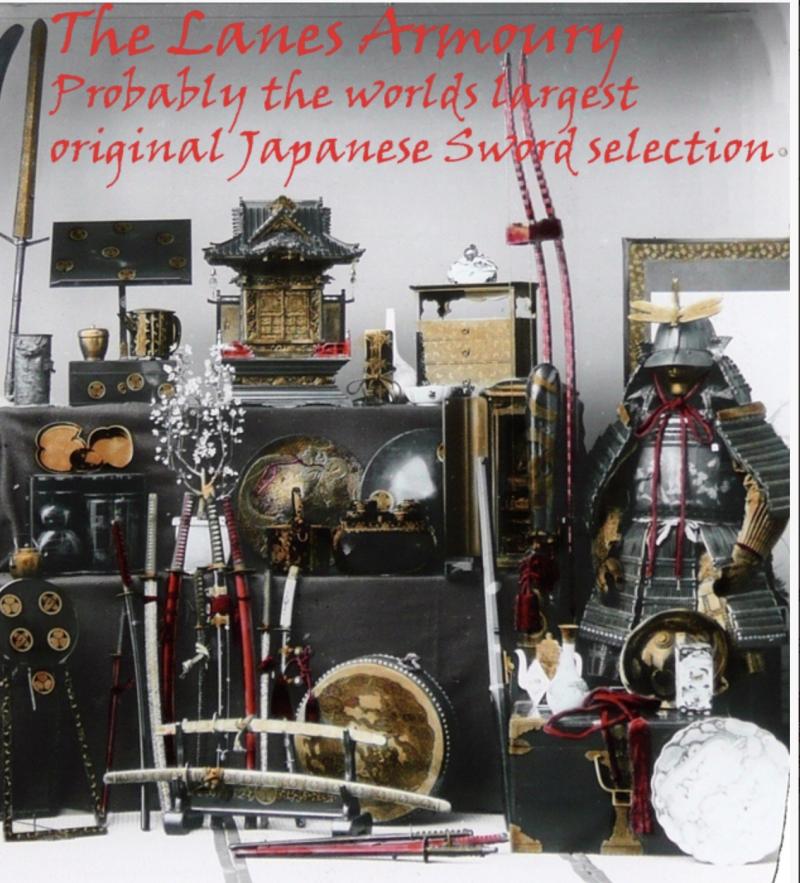Japanese
A Most Pleasant Reminder of An Interview We Gave With The Japanese Press
We received a most pleasant surprise from a Japanese friend who works in the Japanese Consulate in Piccadilly, London.
It was his copy of a most informal interview that we gave during our stock listing, it was a boiling hot summers day, and our air con was struggling.
It was with a most polite and courteous journalist {they all are in fact} from a Japanese newspaper a little while ago. read more
Price
on
Request
An Edo Period Armourer's Myochin School Chrysanthemum Katana Tsuba
Iron plate tsuba in circular shape with omote and ura surfaces showing multiple hot stamp kiku stamp designs.
Tsuba were made by whole dynasties of craftsmen whose only craft was making tsuba. They were usually lavishly decorated. In addition to being collectors items, they were often used as heirlooms, passed from one generation to the next. Japanese families with samurai roots sometimes have their family crest (mon) crafted onto a tsuba. Tsuba can be found in a variety of metals and alloys, including iron, steel, brass, copper and shakudo. In a duel, two participants may lock their katana together at the point of the tsuba and push, trying to gain a better position from which to strike the other down. This is known as tsubazeriai pushing tsuba against each other. read more
295.00 GBP
A Very Good, Antique, Edo Period 1700's, Wakazashi Maru Gata Heianjo Tsuba
Antique Japanese Edo period tsuba for wakizashi sword or large o-tanto
Fine engraved with gold and high quality brass inlay Heianjo-style that was established in Yamashiro (Kyoto Pref. today). It was inspired by the Ounin-style.
Heianjo tsuba are elaborate and most decorative. It is mainly iron tsuba, of circular shape with brass inlay. Its designs were simply family crests, or arabesque patterns in the beginning. However, as time past they made different shapes of tsuba and started using gold, silver, or copper for inlaying.
The tsuba, is a fundamental element in the mounting of the Japanese sword, it is the guard, the most important element of the fittings, and has two main functions: the first to protect the hand against the slashes and lunges of an opposing sword; the second is to prevent that the hand ends up directly on the cutting edge of the blade. Over the course of more than ten centuries of history, the tsuba has undergone a number of important changes, as regards the materials used for its manufacture and its appearance.
During the centuries of wars that characterised Japan until the advent of the Tokugawa Shogunate during the first half of the 17th century, the tsuba was essentially made of iron or steel. From the mid-17th century onwards the tsuba became a real work of art, with the use of soft metals used in various ways, with engravings, incrustations; well made tsuba were the pride of hundreds of craftsmen’s schools whose value sometimes exceeded that of the same blades of the mounting where tsuba was part of.
66mm across. read more
375.00 GBP
An Edo Period Iron Mokko Form Tsuba Engraved with Geometric Manji Design
The tsuba, is a fundamental element in the mounting of the Japanese sword, it is the guard, the most important element of the fittings, and has two main functions: the first to protect the hand against the slashes and lunges of an opposing sword; the second is to prevent that the hand ends up directly on the cutting edge of the blade. Over the course of more than ten centuries of history, the tsuba has undergone a number of important changes, as regards the materials used for its manufacture and its appearance.
During the centuries of wars that characterised Japan until the advent of the Tokugawa Shogunate during the first half of the 17th century, the tsuba was essentially made of iron or steel. From the mid-17th century onwards the tsuba became a real work of art, with the use of soft metals used in various ways, with engravings, incrustations; well made tsuba were the pride of hundreds of craftsmen’s schools whose value sometimes exceeded that of the same blades of the mounting where tsuba was part of.
72 mm. height read more
225.00 GBP
A Koto Period O-Sukashi Katana Tsuba
Circa 1550. Tsuba were made by whole dynasties of craftsmen whose only craft was making tsuba. They were usually lavishly decorated. In addition to being collectors items, they were often used as heirlooms, passed from one generation to the next. Japanese families with samurai roots sometimes have their family crest (mon) crafted onto a tsuba. Tsuba can be found in a variety of metals and alloys, including iron, steel, brass, copper and shakudo. In a duel, two participants may lock their katana together at the point of the tsuba and push, trying to gain a better position from which to strike the other down. This is known as tsubazeriai pushing tsuba against each other. read more
375.00 GBP
A Most Interesting Late Edo Japanese Gilt Lacquer Wooden Sword and Samurai Artifact Folding Display Stand. Decorated with Hand Painted Cranes and Bamboo
A folding wood and hand painted lacquer sword rack display stand, for the display of three samurai swords and for the area beneath for the decoration of samurai artefacts such as sword fittngs, mempo, abumi, war fans, or, such as beautiful Japanese tea ceremony pieces, early iron water vessels, and tea bowls etc.
See a selection of items shown for illustrative purposes.
Signed by the artist on both the obverse and reverse side. The hand painted cranes and bamboo are on fine gold leaf covered panels, and show considerable age wear, but this enhances its air of contrived antiquity for the display of early samurai swords, weaponry and artefacts
It has long been the tradition of areas of Japanese art to make for display late Edo pieces, in the much earlier ancient forms and styles. Such as, for example, russetted Higo style iron sword mounts. Actually made in the 18th century, but made to appear as they were ancient iron pieces from many centuries before. In many respects as an homage to much revered ancient Japanese art forms read more
1425.00 GBP
A Good Antique Edo Period Round Signed Tetsu Wakazashi Tsuba Embossed Seashells
A delightful iron round tsuba takebori patterned with various shells over a water pattern background, with ana openings for kozuka and kogai. The Tsuba can be solid, semi pierced of fully pierced, with an overall perforated design, but it always a central opening which narrows at its peak for the blade to fit within. It often can have openings for the kozuka and kogai to pass through, and these openings can also often be filled with metal to seal them closed. For the Samurai, it also functioned as an article of distinction, as his sole personal ornament 61 mm read more
225.00 GBP
An Edo O Sukashi Wakazashi or Tanto Tsuba In Iron
Circa 1650. The Tsuba, or Japanese sword guard, is a refined utilitarian object. It is essentially a sheath for the blade to fit through, protecting the hand of the warrior. The Tsuba can be solid, semi pierced of fully pierced, with an overall perforated design, but it always a central opening which narrows at its peak for the blade to fit within. It often can have openings for the kozuka and kogai to pass through, and these openings can also also often be filled with metal to seal them closed. For the Samurai, it also functioned as an article of distinction, as his sole personal ornament. read more
265.00 GBP
The Lanes Armoury & The Hawkins Family Established For Over 100 Years
In fact the family has been trading in Brighton for likely 200 years, but the first 100 Years was in the local fish and shellfish trade, becoming shopkeepers in antiques in the town in the last 100 years. Apparently the family moved from our seafaring roots in Plymouth, around 200 years ago, where we had been trading since the 1500’s, and during reign of The Tudors, Admiral Sir Francis Drake had been an adopted apprentice from the age of 15 of the Hawkins family in Plymouth..
The current partners, Mark and David have between them almost 95 years combined service to the company, serving the public and trade in ‘The Lanes’ of Brighton. In fact, we believe, out of approximately 2000 shops, and goodness knows how many businesses in the city, we are now the oldest, remaining, established family traders within the whole of Brighton and Hove.
BRIGHTON and Hove has been named the second-best area for independent shopping in the United Kingdom, only just pipped at the post by Cambridge. If you are going to be beaten by a town at least it was Cambridge [apologies to Oxford, but you ought to be used to it by now]
Taken from the Brighton and Hove.gov website; ‘The Lanes’ is listed first of the four main shopping areas; ‘ The Lanes - historic maze of alleyways with a mix of antiques, jewellery and fashion’
But sadly, we are the only antique and bookshop now still remaining in ‘The Lanes’ read more
Price
on
Request
A Very Rare WW2 Japanese Shell Case From a Type 11 37mm Infantry Anti Tank Gun
Souvenir of an British officer gifted to him by an Australian officer, who served in the Pacific War in WW2. All Japanese munitions from WW2 are incredibly rare to see in the UK as so few returning soldiers bothered to collect them and bring them home, plus all WW2 arms of all kinds were destroyed in Japan from 1945. For them it was a determined effort to wipe out all mention and thought of WW2 and to eradicate any reminder of the shame. All marked items of that period were banned, and in fact a rule that is still enforced in Japan today. The shell schematics are; Calibre Diameter: 37mm
Case Length: 132mm
Rim: R
Round Index: Shell Type 95 AP
Projectile Index: Type 95 AP
Projectile Weight: 0,67000 kg
Filler Weight: 0,03500 kg
Usage: Type 11 37mm Infantry Gun, Type 94 37mm Anti-Tank Gun & Type 94 37mm Tank Gun
Armour piercing/high Explosive round for Type 11 Infantry Gun, early Type 94 AT & Tank Guns. Inert and safe not suitable for export. read more
125.00 GBP


